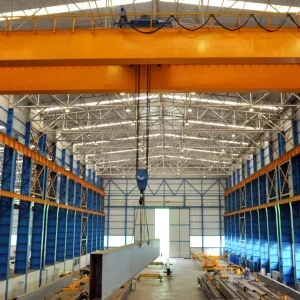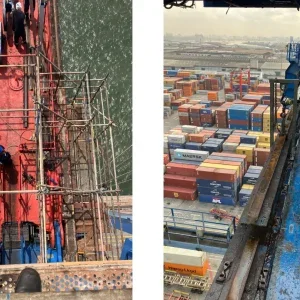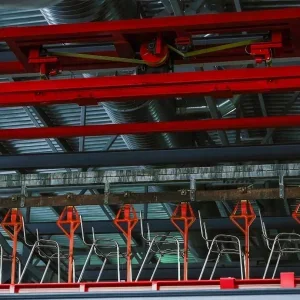History of container crane snag and overload protection
When the container industry started in the early 1960s it grew so fast that engineering focused on ‘build it’ far more than ‘study it’ or ‘test it’. Prototypes were not even considered. As to be expected, a lot of new lessons were learned the hard way.
One lesson was that containers and empty spreader beams would sometimes jam in ships’ cell guides. No problem, some said, as the cranes had been designed strong enough to stall the DC main hoist motor. Yes, but crane operators soon learned they could let out a few wraps of rope and then hoist up full speed to break free of the jam. That structural overload was enough to cause damage and even break hoist ropes that had a theoretical safety factor of five or six. The solution was to add slack rope protection to limit unwrapping the hoist drum and also limit hoisting speed to 50% until hoist ropes were fully taut.
Clearing a jam often required more time than was available before the ship had to leave. It became common to burn the hoist rope, depart, and complete the repair at sea or at the next port. The spreader was returned at the next ship call.
I remember an example sometime from the mid-1970s when a main hoist drum broke loose on a Matson crane in Oakland, California. Somehow the base mounts to the machinery house foundation had broken completely. The obvious explanations were that the slack rope protection must have been bypassed or the mounts must have been defective. Neither was the case.
The crane operator said it happened when he was coming up out of a ship cell with an empty spreader when suddenly the spreader jammed, his cab shook and the hoist was inoperable. This was our introduction to what soon came to be technically defined in the container crane industry as a ‘snag load’.
So what had happened? It was not clear until we looked at energy rather than load. A DC hoist motor lifting a small load has a field weakened top speed of about 200% rated speed. At 200% speed the rotating kinetic energy of the motor and brake disk is 400% more than if the speed was 100%. When the jam occurred this energy had to be instantly transferred elsewhere because the hook suddenly stopped but the hoist drum kept turning, thus increasing tension in the hoist ropes until they broke the drum’s mounts. Some energy goes into rope stretch. The remainder must be taken by structural strain or by damaging an element in the main hoist load path. Usually the spreader structure is the weakest link in the hoist system chain. In this case, the weakest link was the main hoist drum mounts.
Snag load occurs on many other types of hoist systems. It occurs on bridge cranes when an upstop limit switch is not working and the operator pulls the hook into the underside of the trolley.
Container crane owners who were concerned about snag started specifying protection on new crane orders. Several different concepts were tried and the industry settled on energy absorbing hydraulic cylinders as the most practical device. The first credible system was engineered and furnished by Rexroth. It truly understood the technical issues and had the expertise to furnish stroke length, hydraulic plumbing and an energy absorbing orifice that was professionally designed to absorb the snag energy in the extremely short time that was available to avoid excessive rope tension. There never has been a proof test because no owner has been willing to risk a test failure. The snag trip setting is tested by slowly pulling individual cylinders to a specified rope tension. This same trip setting also protects the crane from conventional overload well before the hoist motor reaches stall torque.
True snag events are relatively rare. Trying to lift a container or hatch cover that is still dogged down is far more common. In some ports this occurs a few times almost every ship call.
Crane mechanics make no distinction between low speed overload due to a dogged down container and the high speed event we term as snag. Any time a snag device trips they call it a snag load. Our TLSS (trim, list, skew and snag) system works for both. So does a well designed hydraulic system. A poorly designed hydraulic system will work fine for low speed overload but is unlikely to protect against spreader damage when there is a high speed snag event.
Trim, list, skew (TLS)
Container crane main hoists have four independent sets of wire ropes. Each controls one corner of the spreader beam. A TLS system controls the length of each rope relative to the other ropes. This is used to change the orientation of the spreader/container as follows:
– Trim adjusts the container to match the trim of the vessel. That is bow high or bow low. It is achieved by lengthening the pair of ropes at one end of the spreader while shortening the pair of ropes at the other end.
– List adjusts the container to match the list of the vessel. List is achieved by lengthening the pair of ropes at one side of the spreader while shortening the pair of ropes at the other side.
– Skew adjusts the container as needed when a truck driver fails to stay parallel to the dock. Skew is achieved by lengthening the pair of ropes on diagonal corners of the spreader while shortening the pair of ropes on the other diagonal corners.
– Trim, list, skew and snag (TLSS) can be provided by a mechanical or hydraulic device that can adjust each rope length and also release at a predetermined rope load to provide snag or overload protection.
Alternatively, separate devices can be provided; one to do TLS and the other to be a snag overload system (SOS).
Mechanical TLSS system
The patented tapered dual diameter TLSS drum in Figure 1 is the key element. The snatch block (1) is set at an angle to direct TLSS drum rope (2) to go over the drum’s smaller diameter while TLSS drum rope (3) goes under the drum’s larger diameter at a fixed number of grooves apart from TLSS drum rope (2).
Turning the TLSS drum one way or the other way with the motor reducer (4) adjusts dimension (5) as needed to set the length of one of the crane’s four parts of main hoist ropes. For each degree of clockwise (7) turn, rope (3) at the larger diameter spools out further than rope (2) takes in. Therefore, dimension (5) increases. Counterclockwise is vice versa.
The other three TLSS drums are turned to set the lengths of the other three parts of the main hoist ropes. This means the crane operator can precisely set a desired TLS.
The TLSS drum ropes are operating at equal tension but at different drum diameters. This causes clockwise drum torque which is resisted by a friction clutch (6).
A friction clutch (6) is designed to precisely release at an adjustable torque but still retain retarding friction. The torque setting is the torque that is developed when tension in the main hoist ropes increases to the allowable limit for snag/overload setting.
In addition to the tapered drums and sheaves shown in Figure 1, a complete TLSS system includes:
– A Bubenzer fast setting main hoist emergency brake. This is the brake that absorbs most of the snag rotating kinetic energy.
– Bubenzer motor brakes with ‘low inertia’ disks. Most of the snag kinetic energy is generated by the rotating mass of motor and motor brake disks which are spinning very fast when the crane is lifting an empty spreader at full speed. The low inertia disks reduce the rotating energy and that reduces the snag load on the crane.
– A Malmedie friction clutch that is designed to partially release at a specified torque and then continue to absorb energy until all motions come to a stop.
For snag, when the Malmedie friction clutch slips the TLSS drum immediately starts to spin and dimension (5) rapidly increases. This helps control the main hoist rope tension during the time it takes for the Bubenzer fast setting main hoist emergency brakes to stop the main hoist motors and the Bubenzer low inertia motor brake disks’.
An interesting feature of the TLSS tapered dual diameter drum occurs during snag arrest. Note that as the grooves at rope (2) fill and the rope starts to climb up the left taper segment, the grooves at rope (3) empty and the rope starts to climb down the grooves in the other tapered segment. As this is happening, the drum torque is getting less and less because the difference in active drum diameters is getting less and less. When the active grooves for both ropes are equal diameter the torque is zero. Then the torque starts to reverse which slows the spinning TLSS drum.
But that is not all. While the TLSS drum torque is diminishing, the main hoist rope tension is increasing because the main hoist motor and brake disc has not yet stopped. When the main hoist system does stop there is residual tension in the main hoist ropes.
Figure 2 depicts a possible arrangement of the TLSS system. A similar arrangement could be used to accommodate horizontal main hoist ropes. Guides would be needed to support and align horizontal snatch blocks.
Figure 3 is a typical TLSS time history plot, in milliseconds (ms), of main hoist rope tension from the instant a snag event starts until the TLSS system and main hoist system has stopped at time 910ms with residual tension in the main hoist ropes. The TLSS drum continues to rotate and finally stop at time 1,780ms. During this time the friction clutch is damping out the rotating kinetic energy of the TLSS drum. Residual tension remains in the main hoist ropes. After the TLSS drum has stopped, the main hoist can start again with active torque control and unload the residual tension.
Things can go wrong that were not anticipated in a system’s design. For example, what if the hoist overspeeds or oil is spilled on a brake disk. This could cause a hydraulic system to run out of stroke and snap the rope unless the cylinder is cushioned. Unlike a conventional hydraulic system that is not cushioned, the TLSS system would reverse. But the reversal’s softening effect would be similar to a cushioned cylinder softening effect.

Figure 1: The tapered dual diameter TLSS drum

Figure 2: A possible arrangement of the TLSS system

Figure 3:?A typical TLSS time history plot






